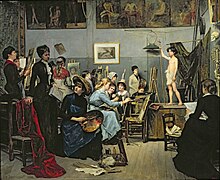
Back ورشة العمل Arabic Atelye Azerbaijani Výtvarný ateliér Czech Ateliero Esperanto آتلیه Persian Ateljeeopetus Finnish Atelier ID Atelier Italian アトリエ Japanese 화실 Korean




An atelier (French: [atəlje]) is the private workshop or studio of a professional artist in the fine or decorative arts or an architect, where a principal master and a number of assistants, students, and apprentices can work together producing fine art or visual art released under the master's name or supervision.
Ateliers were the standard vocational practice for European artists from the Middle Ages to the 19th century, and common elsewhere in the world. In medieval Europe this way of working and teaching was often enforced by local guild regulations, such as those of the painters' Guild of Saint Luke, and of other craft guilds. Apprentices usually began working on simple tasks when young, and after some years with increasing knowledge and expertise became journeymen, before possibly becoming masters themselves. This master-apprentice system was gradually replaced as the once powerful guilds declined, and the academy became a favored method of training. However, many professional artists continued using students and assistants as they had been in ateliers; sometimes the artist paid the student-assistants, while sometimes they paid the artist fees to learn.[1]
In art, the atelier consists of a master artist, usually a professional painter, sculptor, or architect—or from the mid-19th century a fine art photographer—working with a small number of students to train them in visual or fine arts. An atelier can also be the work and study space of a haute couture fashion designer, hair stylist, or artists more generally. Atelier schools can be found around the world, particularly in North America and Western Europe.[2]
Although the methods vary, most painting ateliers train students in the skills and techniques associated with creating some form of representational art, the making of two-dimensional images that appear real to the viewer. They traditionally include sessions for drawing or painting nude art.
- ^ Diana Davies (editor), Harrap's Illustrated Dictionary of Art and Artists, Harrap Books Limited, (1990) ISBN 0-245-54692-8
- ^ Janson, H. W.; Janson, Anthony F. (1995). History of Art (5th ed.). London: Thames & Hudson. p. 629. ISBN 0500237018.
© MMXXIII Rich X Search. We shall prevail. All rights reserved. Rich X Search